terradas
New member
I have a mysterious blue spot that appeared on my male standingi recently and I have no clue what it is. The only thing I can think of is a possible burn from basking under a halogen puck light. He only has this spot in one area and the female has no signs of this. It shows no sign of puss or blood, but I don't know what it could be if not a burn. The pair gets along just fine and the mark doesn't look like a bite wound. Any thoughts are welcomed!

Also, he's shedding in the picture so it is not a simple matter of fresh colors from under old skin.

Also, he's shedding in the picture so it is not a simple matter of fresh colors from under old skin.


